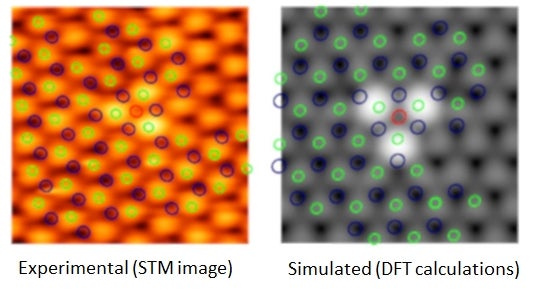Localised excitons in 2D materials for integrated quantum optics
QUEK Su Ying (Group Leader, Physics) July 08, 2019NUS scientists have found that the oxygen interstitials in single-layer tungsten diselenide (WSe2) enable it to function as single photon emitters (SPEs) for quantum optical applications.
Two-dimensional (2D) materials with atomically thin honeycomb-like lattices were recently discovered experimentally for use as SPEs. SPEs emit light as single particles or photons one at a time and they play an important role in quantum optics and quantum information processing. SPEs developed using 2D materials such as WSe2, provide flexibility for potential device and circuit integration in a semiconductor manufacturing environment. However, the nature of these experimentally discovered SPEs in WSe2 is not clear and this hinders their potential use in quantum applications.
Prof Su Ying QUEK from the Department of Physics, NUS and her research team have identified that the single photon emissions coming from the localised exciton states in WSe2 were due to the oxygen interstitials present in the single-layer 2D material. The research team used a combination of theoretical computations and experimental approaches to arrive at the outcome. With better understanding of the origins of single photon emissions, the findings could help in the development of SPEs using 2D materials and to improve their emission performance.
In their research work, the team did not manage to find correlations between the density functional theory computations on intrinsic point defects in the WSe2 material with the experimentally obtained spectra from scanning tunnelling spectroscopy. They then focused on the oxygen-related point defects associated with the WSe2 material. These defects could be incorporated easily into the material during the synthesis process or by ambient passivation. Through an elimination process, they found that defects associated with oxygen interstitials in the lattice are most likely to be producing the localised exciton states in the experimentally observed spectral positions.
Prof Quek said, “This work provides a detailed study of point defects in monolayer WSe2 and predicted the nature and energies of excitons at these defect sites. Deciphering the origin of the single photon emitters will be useful for the development of quantum emitters using other 2D materials for quantum optical applications.”

Figure shows a comparison of the scanning tunnelling microscopy (STM) image of the observed oxygen interstitials associated point defect with the predicted image obtained from density functional theory (DFT) calculations. Atomic positions are indicated (red: oxygen, blue: tungsten, green: selenium). The fine features of the experimental and simulated STM images were found to agree well over a range of different applied voltages. Scanning tunneling spectroscopy showed that there were no gap states, consistent with the theoretical predictions. [Credits: ACS Nano]
Reference
Zheng YJ; Chen YF; Huang YL; Gogoi PK; Li MY; Li LJ; Trevisanutto PE; Wang QX; Pennycook SJ*; Wee ATS*; Quek SY*, “Point Defects and Localized Excitons in 2D WSe2” ACS NANO Volume: 13 Issue: 5 Pages: 6050-6059 DOI: 10.1021/acsnano.9b02316 Published: 2019.


